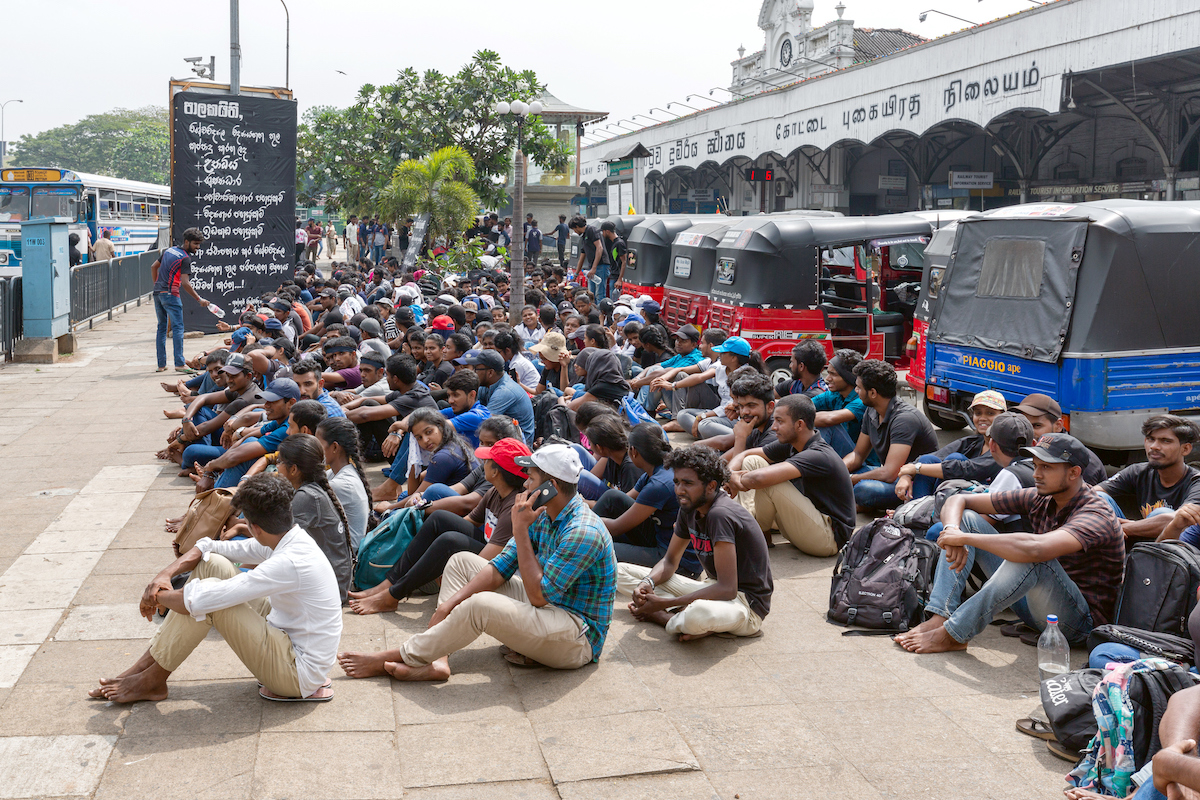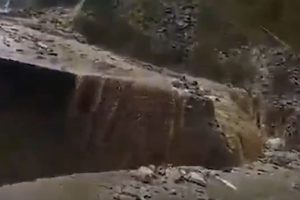Tall high-rise buildings dot the seafront of Colombos Galle Face. Most are international hotel chains, and one is a swanky upmarket shopping mall – a nod to the fast-paced construction and development work that Galle Sea Face has witnessed in recent years. As the gaze sweeps out towards the Indian Ocean, the fluttering flags of the under-construction Colombo Port City catch the eye. Touted as the next Dubai or Singapore of the subcontinent, it is being constructed with Chinese help on land reclaimed from the sea. And a little distance away from it inland, at the northern end of Galle Face, overlooking the ocean, is the majestic yellow Neo-Baroque-style building: the Presidential Secretariat, the office of the president since 1983 and currently the heart of the protests that are roiling Sri Lanka.
The resentment against the Sri Lankan government’s mishandling of the economy had been growing in the country since last year. Sri Lanka’s two million farmers have been protesting for months against the government’s decision to go “organic” and the subsequent order banning the import of chemical fertilisers in April 2021. It reached a flashpoint in October when they took their protest to Colombo and threatened to cut off supplies to the capital. By November, the government rolled back its earlier decision and allowed imports. Steep price rises of essentials like rice, lentils, flour, milk, eggs, and cooking gas put a strain on most households.
But the tipping point came when rolling power cuts, sometimes more than 10 hours a day, were imposed island-wide. Overnight, people were staring at crippling shortages, serpentine queues for petrol, diesel and cooking gas, and restrictions on the quantities of food items one could buy. Pharmacies, too, were running low on essential life-saving drugs as 80 per cent of the medicines in the country were imported.
All this coalesced into a massive street protest of a million people calling for the president and his government to resign. A curfew was clamped in the western province, social media was blocked for almost 13 hours, and then a general public emergency was declared on April 1 this year. Sensing growing public defiance and anger, the president rescinded the emergency orders on April 5. April 3 saw his entire cabinet of ministers – except the prime minister, who is the president’s brother – resign. This week, a new cabinet was sworn in.
“Go Home Gota” has become the rallying cry of the protesters. The massive protest has turned into an all-night vigil near the Presidential Secretariat. Protesters have braved heavy rain and thunderstorm to stay there. Temporary tents have been set up at the protest site that is now being called “Gota-go-Gama” (Gama is Sinhala for village). Crowds typically swell during the day and on holidays. Many come to the site after finishing work. Others bring their children to witness and be part of the movement. The aged and the infirm sit in wheelchairs holding placards. Protesters flank the road near the secretariat waving the Sri Lankan national flag, shouting slogans and holding placards that say “Gota Go Home,” “Pissa (lunatic) go home,” “Bring our money back,” “Leave my future alone,” “You have messed with the wrong generation.”
In a city that barely sees any honking, cars passing through blow their horns in a show of solidarity with the protesters. The orderly behaviour of the crowd is almost sur- real. Except for the torching of a couple of police vehicles on March 31, (when the police used force and fired tear gas shells), the protests have remained non-violent. The only persons in the uniform present at the site are traffic policemen regulating the flow of traffic.
The protest site itself is a study of civic awareness. There is no littering. Empty plastic water bottles have been strung together to read “Go Home Gota” and hung on the fence bordering the promenade. The rest have been corralled into nets to be recycled later. Waste, too, is segregated and sorted at the site. A couple of ambulances are stationed nearby to take care of any medical exigency. Free food and beverage are distributed among the protesters. All this is being managed through spontaneous and voluntary individual contributions.
People from all walks of life, from all faiths and beliefs and from across the island, including the indigenous Vedda community, find representation here. Muslims break their Ramadan fast here with food and prayers. Buddhists and Christians have held vigils, and the Sinhala and Tamil people have marked their biggest festival, the New Year on April 14, together.
So how did Sri Lanka descend into this economic free fall? Today, inflation is at a record high of 18.7 per cent, with food inflation at over 30 per cent. The Sri Lankan rupee (LKR) shows no signs of stabilising. Within days of the government free-floating it, the rupee fell steeply – from 203 rupees against a US dollar on March 7 to around 330 rupees against a US dollar now. The Central Bank of Sri Lanka has announced its decision to unilaterally suspend external debt repayments of USD 51 billion. Additionally, it is seeking immediate help from the International Monetary Fund (IMF) to manage the balance of payment situation.
As an island nation, Sri Lanka was always dependent on imports to sustain its economy. But indiscriminate borrowings for big infrastructure projects, which typically have low yields and long turnaround times, have tilted the already fragile foreign exchange reserves against it. Fiscal mismanagement and Covid-induced economic downturn played their part. Sri Lanka has long relied on foreign tourists and remittances from its manpower exports for its dollar earnings. Covid effectively put a stop to that.
A series of missteps by the incumbent government aggravated an already precarious situation. In its desire to become the first nation in the world to go completely “organic,” the government in April 2021 banned the import of all chemical fertilisers. The decision had catastrophic consequences. Farm yields fell by a whopping 33 per cent and Sri Lanka, which used to be self-sufficient in paddy cultivation, had to import rice from its neighbouring countries to make up for the shortfall. Tea production and export, a traditional foreign exchange earner, also declined substantially.
Sri Lankan forex reserves fell to $1.93 billion at the end of March this year; foreign debt repayment of $4 billion is due this year. The Sri Lankan government has been forced to default on all its foreign debt repayments to preserve its forex reserves for essential imports. As it awaits financial assistance from the IMF, neighbouring countries have come forward to help Sri Lanka. Bangladesh offered credit worth $200 million in June 2021, which has been rolled over. India has opened a credit line worth $2.4 billion to cover essential imports of diesel, petrol, medicines, cooking gas and rice. The Singapore Red Cross has committed 100,000 Singaporean dollars for urgent medical supplies. Sri Lanka has also received $10 million from the World Bank to buy essential medicines.
The resolve of the Sri Lankan people at the protest site is almost palpable. They have rebuffed calls from the prime minister for talks and find it difficult to believe when the president says that the current situation was not of his making. Their concerns echo in former Prime Minister Ranil Wickremesinghe’s message to the president: resign or explain to the people why you won’t.











